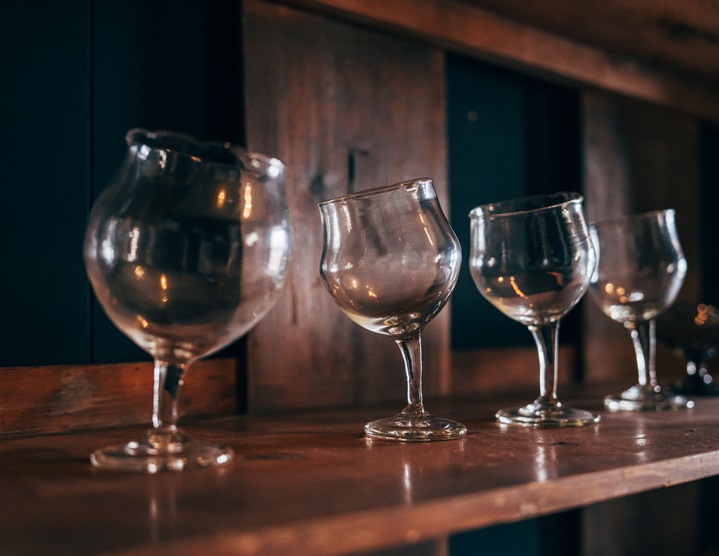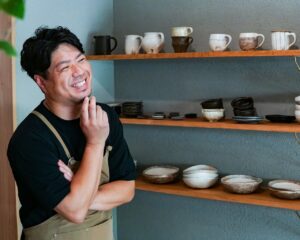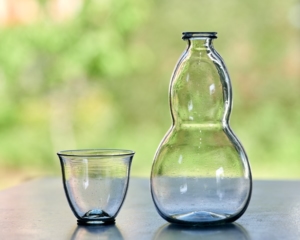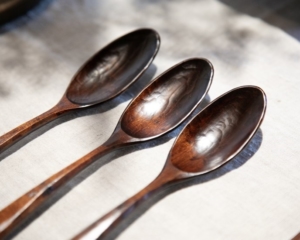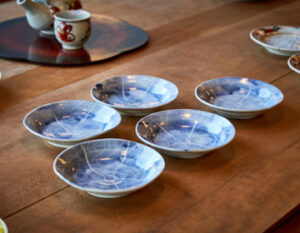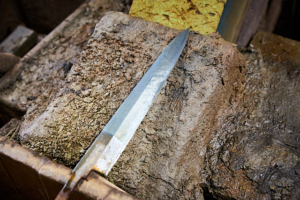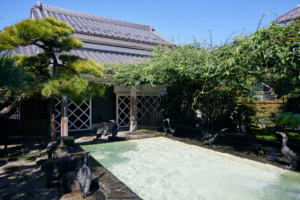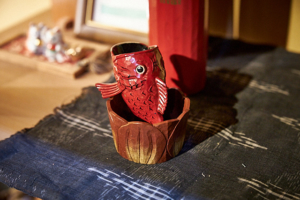The Shioyama area of Koshu City, located in the northeastern part of Yamanashi Prefecture, is blessed with abundant nature represented by “Daibosatsu Ridge,” one of the 100 most famous mountains in Japan, and rich historical assets such as the village of “Shioyama Shimo-Odawara Kamijo,” an important preservation district for traditional buildings, and the “Former Takano Family Residence,” a national treasure and important cultural asset from the late Edo period. When we visited COMAKI GLASS, a glass studio nestled in the mountains, we found a lineup of glasses with bowls tilting as if “twirling” to the right and left.
Glass Studio in a Mountain Village

Around the workshop in the Shioyama area of Koshu City, there is a farming village with a scenic view of a mountain range and houses that retain the atmosphere of the old days when farmers cultivated fields and raised silkworms. After a hard day’s work, the scenery and the cool air are soothing to me,” he says. Glass artist Kohei Komaki looks out the window with a bead of sweat on his forehead. He creates his works by “blowing glass,” which involves wrapping glass melted at high temperatures around a blowpipe and blowing in the air.
The “Unexpected” Appeal of Blown Glass

The term “glass blowing” can be divided into two techniques. One is the “katabuki” method, in which glass is inserted into a mold and blown into the mold to efficiently produce the same shape. The other is the “air-blowing method” used at COMAKI GLASS. The air is blown into the air and the glass is formed using only gravity and the centrifugal force of the blowing rod, making it less efficient than the mold-blowing method.
The interesting thing about the air-blowing method is that the glass itself creates unexpected shapes,” says Komaki. Some of COMAKI GLASS’s wine and beer glasses, which are described as “original,” are made of “recycled glass,” which is hard and cools relatively easily, depending on the individual piece. Some of the works have a deep flavor that makes the most of the material’s characteristics.

Each glass has its own character. No two glasses are the same, and I try to express the form and aspect of the glass that has been formed by the glass itself.
The stem, which is bent as if to tilt the head, and the curved mouthpiece, which gives a different feel to the mouth, are truly unique in shape. When you look at the glasses lined up in a row, they look like they are dancing and swaying happily,” he says, gazing lovingly at his work.
Mr. Komaki says he originally enjoyed ceramics, woodworking, and painting. Rather than realistic and elaborate objects, he is more moved by things that he can see and feel, especially abstract paintings and creative expressions. His interest in glass making and other arts and crafts was sparked by his grandfather, whom he saw when he was a child.
My grandfather’s words and my encounter with glass artist Funaki Waho

Mr. Komaki says that since he was a child, he was close to his grandfather, who painted pictures as a hobby. As he was drawn to arts and crafts, he gradually began to dream of becoming a glassblower, following the words of his grandfather, who always said, “If I could be young again, I would like to make glass.
It was not until he was a university student that he finally came into contact with glass. He found a studio that offered facilities for the general public and began making glass, which he had longed to do. Later, when he began to think about pursuing glass making in earnest, he came across the work of Funaki Shizuho, a glass artist who would later become his mentor.
The gentle warmth of the form and the coolness unique to glass gave me a sense of clarity when I looked at it,” says Komaki. She immediately wrote to Mr. Funaki and asked to study under him, but it so happened that there was a vacancy for an assistant, and upon graduation she moved to Kanbe-cho, Hiroshima Prefecture. He moved to Kanbe-cho, Fukayasu-gun, Hiroshima Prefecture, at the same time as graduation, and began his apprenticeship at Funaki’s studio, Glasshütte Funaki, where he studied glass making in earnest.
Anticipate coincidences, live diligently.

Funaki’s vases, plates, bowls, glasses, and bowls are made by hand, utilizing the characteristics of the materials, from design to finish, and are characterized by their warmth and artistic quality, while being highly practical and robust. Even after his passing, Funaki’s work continues to be highly acclaimed both within and outside of the craft industry. Looking back over the past six years, Mr. Komaki says, “It took a lot of hard work to become able to work together as an assistant. Despite his mature skills, Mr. Funaki always approached his work with humility. “He had a loving kindness, but he was strict and stoic about his work,” Komaki says.
He was a man of love and kindness, but also strict and stoic in his work,” says Komaki. “What I learned from Mr. Funaki, such as ‘to expect coincidences’ and ‘to live diligently,’ is still at the core of my work today. After learning techniques and how to be an artist through training, Mr. Funaki became independent. Seeking a spacious place to make glass, he set up his own studio in his father’s hometown of Minami-Alps City, Yamanashi Prefecture.
It is only in the last few years that I have finally been able to make a living solely from my own work. Looking back, I learned very little about ‘selling,'” he says with a wry smile. Immediately after becoming independent, he worked part-time while producing his works. He held solo exhibitions at galleries around the country and gradually expanded his connections with people who shared the same values. Through these steady activities, the number of production requests gradually increased.
The word “happenstance” moves the heart.

In 2020, the studio was relocated to its current location in Shioyama, Koshu City, in search of an even larger work space. In 2020, Komaki will move his workshop to Shioyama, Koshu City, in search of a larger work space. He will pursue technical and expressive “fun,” and focus on producing the unique stemmed glasses that have become synonymous with his work.
The area that touches the lips and the texture of the mouth changes the taste,” says Komaki, tilting his own glass as he pours a beer into it. The workshop has a large number of glasses on display, but in fact, most of them are prototypes. For example, when adjusting the thickness or adding patterns, the slightest amount of force applied with a metal tool called a “jack,” can make a big difference in the finished product. No matter how much he continues to hone his skills, the moment when he comes across a piece that he thinks is good is always a “fluke.
He says, “The impression will change depending on the situation and purpose of use in daily life. I want to use the glasses I make myself, and I try to actively ask people what they think of them,” he says. From many prototypes, he seeks out points for improvement and hints by actually using them himself. This stoic and flexible attitude is what creates works that move the hearts of those who see and use them.
In a day that tends to drift by
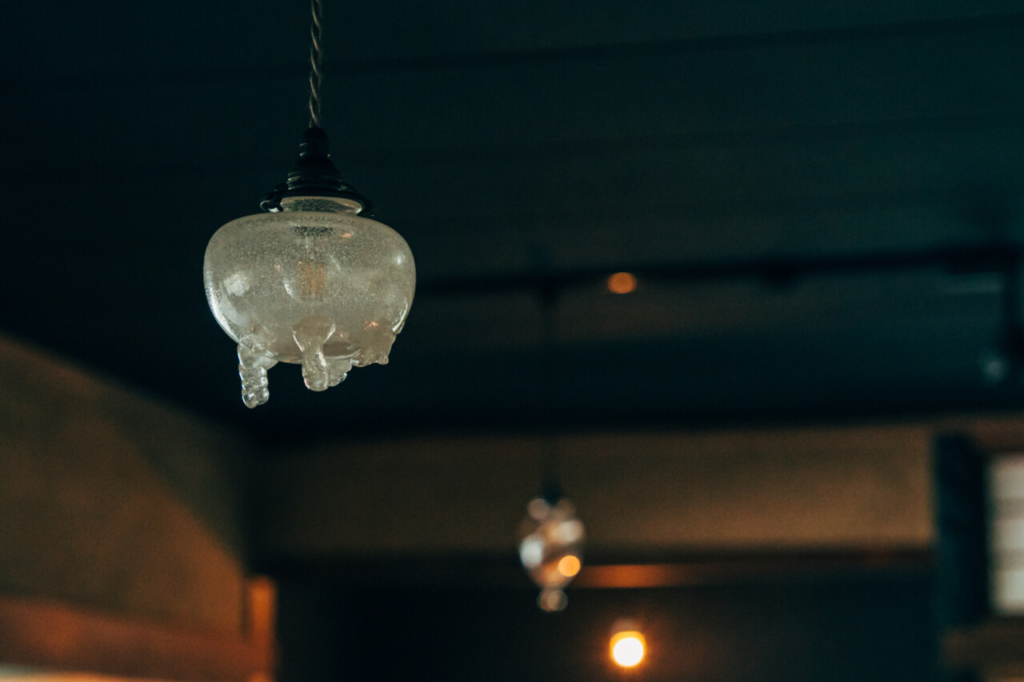
Mr. Komaki is actively involved in the local community. He says that it has been a great opportunity to meet people in the community who support his activities, such as a local miso maker, roof tile craftsman, and winery. The tips and inspiration he has received through these relationships have been numerous, and he has gradually begun to receive orders for lampshade production, something he had never done before. In recent years, he has been receiving an increasing number of requests from local restaurants for glasses with curved legs.
While realizing that his work is gradually gaining popularity, he says that he would like to continue to refine his ideas and sensitivity through various inputs such as these exchanges, encounters at solo exhibitions held in various places, and things he happens to see on his travels.

“I’m sure my mind is crooked, too. It’s interesting to see things take a shape you never thought they would.”
He has a firm belief in his work, but at the same time, his eyes are full of a certain “wavering” quality. The works of COMAKI GLASS are infused with the personality of Mr. Komaki himself. I think that the works of COMAKI GLASS are infused with such a personality of Mr. Komaki himself. In this age of fast-paced production and consumption of mass-produced goods, it is important to take a break in our daily lives. Why don’t you enjoy a moment to admire the “shimmering” one-of-a-kind pieces that accompany the daily transitions and changes of the seasons?



